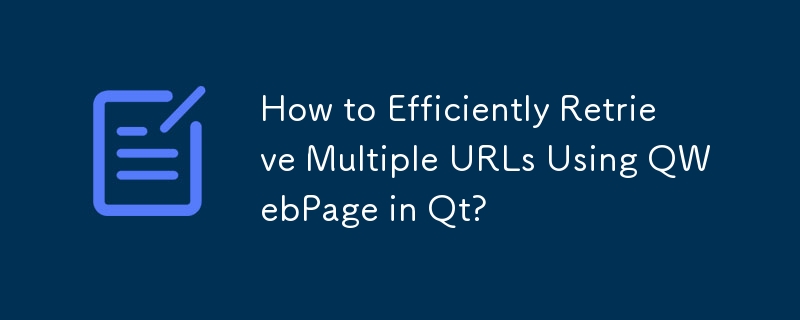Qt에서 QWebPage를 사용하여 여러 URL을 효율적으로 검색하는 방법은 무엇입니까?

QWebPage로 여러 URL 검색
이 시나리오에서는 Qt의 QWebPage를 사용하여 동적으로 업데이트된 페이지를 렌더링하려고 했습니다. 그러나 두 번째 페이지를 렌더링하려고 할 때 자주 충돌이 발생했습니다.
문제 분석
문제는 접근 방식에 있습니다. 각 URL 가져오기에 대해 새로운 QApplication 및 QWebPage를 초기화하고 있습니다. 대신, 동일한 인스턴스 내에서 여러 URL을 처리하기 위해 신호 및 사용자 정의 처리를 사용하여 단일 QApplication 및 QWebPage를 유지하는 것이 좋습니다.
제안 솔루션
WebPage 클래스
다음은 PyQt5 및 PyQt4용 사용자 정의 WebPage 클래스입니다.
PyQt5 WebPage
<code class="python">from PyQt5.QtCore import pyqtSignal, QUrl
from PyQt5.QtWidgets import QApplication
from PyQt5.QtWebEngineWidgets import QWebEnginePage
class WebPage(QWebEnginePage):
htmlReady = pyqtSignal(str, str)
def __init__(self, verbose=False):
super().__init__()
self._verbose = verbose
self.loadFinished.connect(self.handleLoadFinished)
def process(self, urls):
self._urls = iter(urls)
self.fetchNext()
def fetchNext(self):
try:
url = next(self._urls)
except StopIteration:
return False
else:
self.load(QUrl(url))
return True
def processCurrentPage(self, html):
self.htmlReady.emit(html, self.url().toString())
if not self self.fetchNext():
QApplication.instance().quit()
def handleLoadFinished(self):
self.toHtml(self.processCurrentPage)
def javaScriptConsoleMessage(self, *args, **kwargs):
if self._verbose:
super().javaScriptConsoleMessage(*args, **kwargs)</code>PyQt4 WebPage
<code class="python">from PyQt4.QtCore import pyqtSignal, QUrl
from PyQt4.QtGui import QApplication
from PyQt4.QtWebKit import QWebPage
class WebPage(QWebPage):
htmlReady = pyqtSignal(str, str)
def __init__(self, verbose=False):
super(WebPage, self).__init__()
self._verbose = verbose
self.mainFrame().loadFinished.connect(self.handleLoadFinished)
def process(self, urls):
self._urls = iter(urls)
self.fetchNext()
def fetchNext(self):
try:
url = next(self._urls)
except StopIteration:
return False
else:
self.mainFram().load(QUrl(url))
return True
def processCurrentPage(self):
self.htmlReady.emit(self.mainFrame().toHtml(), self.mainFrame().url().toString())
if not self.fetchNext():
QApplication.instance().quit()
def javaScripConsoleMessage(self ,* args, **kwargs):
if self._verbose:
super(WebPage, self).javaScriptConsoleMessage(*args, **kwargs)</code>사용법
다음은 이러한 WebPage 클래스를 사용하는 방법에 대한 예입니다.
<code class="python">from PyQt5.QtCore import QUrl from PyQt5.QtWidgets import QApplication # PyQt5 url_list = ['https://example.com', 'https://example2.com'] app = QApplication(sys.argv) webpage = WebPage(verbose=True) webpage.htmlReady.connect(my_html_processor) webpage.process(url_list) sys.exit(app.exec_()) # PyQt4 from PyQt4.QtCore import QUrl from PyQt4.QtGui import QApplication url_list = ['https://example.com', 'https://example2.com'] app = QApplication(sys.argv) webpage = WebPage(verbose=True) webpage.htmlReady.connect(my_html_processor) webpage.process(url_list) sys.exit(app.exec_())</code>
이 코드에서 my_html_processor는 처리된 HTML 및 각 페이지의 URL 정보.
이 접근 방식을 구현하면 이전에 경험했던 충돌과 무작위 동작을 방지하여 보다 안정적이고 효율적인 웹 스크래핑 작업 흐름을 얻을 수 있습니다.
위 내용은 Qt에서 QWebPage를 사용하여 여러 URL을 효율적으로 검색하는 방법은 무엇입니까?의 상세 내용입니다. 자세한 내용은 PHP 중국어 웹사이트의 기타 관련 기사를 참조하세요!

핫 AI 도구

Undresser.AI Undress
사실적인 누드 사진을 만들기 위한 AI 기반 앱

AI Clothes Remover
사진에서 옷을 제거하는 온라인 AI 도구입니다.

Undress AI Tool
무료로 이미지를 벗다

Clothoff.io
AI 옷 제거제

Video Face Swap
완전히 무료인 AI 얼굴 교환 도구를 사용하여 모든 비디오의 얼굴을 쉽게 바꾸세요!

인기 기사

뜨거운 도구

메모장++7.3.1
사용하기 쉬운 무료 코드 편집기

SublimeText3 중국어 버전
중국어 버전, 사용하기 매우 쉽습니다.

스튜디오 13.0.1 보내기
강력한 PHP 통합 개발 환경

드림위버 CS6
시각적 웹 개발 도구

SublimeText3 Mac 버전
신 수준의 코드 편집 소프트웨어(SublimeText3)
 Python vs. C : 학습 곡선 및 사용 편의성
Apr 19, 2025 am 12:20 AM
Python vs. C : 학습 곡선 및 사용 편의성
Apr 19, 2025 am 12:20 AM
Python은 배우고 사용하기 쉽고 C는 더 강력하지만 복잡합니다. 1. Python Syntax는 간결하며 초보자에게 적합합니다. 동적 타이핑 및 자동 메모리 관리를 사용하면 사용하기 쉽지만 런타임 오류가 발생할 수 있습니다. 2.C는 고성능 응용 프로그램에 적합한 저수준 제어 및 고급 기능을 제공하지만 학습 임계 값이 높고 수동 메모리 및 유형 안전 관리가 필요합니다.
 파이썬과 시간 : 공부 시간을 최대한 활용
Apr 14, 2025 am 12:02 AM
파이썬과 시간 : 공부 시간을 최대한 활용
Apr 14, 2025 am 12:02 AM
제한된 시간에 Python 학습 효율을 극대화하려면 Python의 DateTime, Time 및 Schedule 모듈을 사용할 수 있습니다. 1. DateTime 모듈은 학습 시간을 기록하고 계획하는 데 사용됩니다. 2. 시간 모듈은 학습과 휴식 시간을 설정하는 데 도움이됩니다. 3. 일정 모듈은 주간 학습 작업을 자동으로 배열합니다.
 Python vs. C : 성능과 효율성 탐색
Apr 18, 2025 am 12:20 AM
Python vs. C : 성능과 효율성 탐색
Apr 18, 2025 am 12:20 AM
Python은 개발 효율에서 C보다 낫지 만 C는 실행 성능이 높습니다. 1. Python의 간결한 구문 및 풍부한 라이브러리는 개발 효율성을 향상시킵니다. 2.C의 컴파일 유형 특성 및 하드웨어 제어는 실행 성능을 향상시킵니다. 선택할 때는 프로젝트 요구에 따라 개발 속도 및 실행 효율성을 평가해야합니다.
 Python 학습 : 2 시간의 일일 연구가 충분합니까?
Apr 18, 2025 am 12:22 AM
Python 학습 : 2 시간의 일일 연구가 충분합니까?
Apr 18, 2025 am 12:22 AM
하루에 2 시간 동안 파이썬을 배우는 것으로 충분합니까? 목표와 학습 방법에 따라 다릅니다. 1) 명확한 학습 계획을 개발, 2) 적절한 학습 자원 및 방법을 선택하고 3) 실습 연습 및 검토 및 통합 연습 및 검토 및 통합,이 기간 동안 Python의 기본 지식과 고급 기능을 점차적으로 마스터 할 수 있습니다.
 Python vs. C : 주요 차이점 이해
Apr 21, 2025 am 12:18 AM
Python vs. C : 주요 차이점 이해
Apr 21, 2025 am 12:18 AM
Python과 C는 각각 고유 한 장점이 있으며 선택은 프로젝트 요구 사항을 기반으로해야합니다. 1) Python은 간결한 구문 및 동적 타이핑으로 인해 빠른 개발 및 데이터 처리에 적합합니다. 2) C는 정적 타이핑 및 수동 메모리 관리로 인해 고성능 및 시스템 프로그래밍에 적합합니다.
 Python Standard Library의 일부는 무엇입니까? 목록 또는 배열은 무엇입니까?
Apr 27, 2025 am 12:03 AM
Python Standard Library의 일부는 무엇입니까? 목록 또는 배열은 무엇입니까?
Apr 27, 2025 am 12:03 AM
Pythonlistsarepartoftsandardlardlibrary, whileraysarenot.listsarebuilt-in, 다재다능하고, 수집 할 수있는 반면, arraysarreprovidedByTearRaymoduledlesscommonlyusedDuetolimitedFunctionality.
 파이썬 : 자동화, 스크립팅 및 작업 관리
Apr 16, 2025 am 12:14 AM
파이썬 : 자동화, 스크립팅 및 작업 관리
Apr 16, 2025 am 12:14 AM
파이썬은 자동화, 스크립팅 및 작업 관리가 탁월합니다. 1) 자동화 : 파일 백업은 OS 및 Shutil과 같은 표준 라이브러리를 통해 실현됩니다. 2) 스크립트 쓰기 : PSUTIL 라이브러리를 사용하여 시스템 리소스를 모니터링합니다. 3) 작업 관리 : 일정 라이브러리를 사용하여 작업을 예약하십시오. Python의 사용 편의성과 풍부한 라이브러리 지원으로 인해 이러한 영역에서 선호하는 도구가됩니다.
 과학 컴퓨팅을위한 파이썬 : 상세한 모양
Apr 19, 2025 am 12:15 AM
과학 컴퓨팅을위한 파이썬 : 상세한 모양
Apr 19, 2025 am 12:15 AM
과학 컴퓨팅에서 Python의 응용 프로그램에는 데이터 분석, 머신 러닝, 수치 시뮬레이션 및 시각화가 포함됩니다. 1.numpy는 효율적인 다차원 배열 및 수학적 함수를 제공합니다. 2. Scipy는 Numpy 기능을 확장하고 최적화 및 선형 대수 도구를 제공합니다. 3. 팬더는 데이터 처리 및 분석에 사용됩니다. 4. matplotlib는 다양한 그래프와 시각적 결과를 생성하는 데 사용됩니다.






